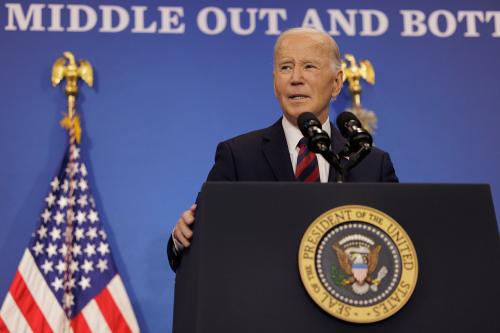The year 2014 was the year that the federal budget deficit largely disappeared from the political debate.
When the books closed on fiscal year 2014 on Sept. 30, revenues were up 9% and spending was up just 1%. Even Medicare grew slowly. The deficit, the gap between income and outlays, was 2.8% measured against the gross domestic product, far from the nearly 10% peak hit during the Great Recession and below the average deficit over the past 40 years. This largely reflects the improving economy and the waning of much of the Obama stimulus; in October and November 2014, the first two months of the federal fiscal year, federal tax receipts were 6% above the same months the year before, and spending was up only 2%.
Congressional Budget Office projections, not much different than those made in the private sector forecasts, projected deficit below 3% of GDP through 2018, rising only gradually after that. In part, this reflects the surprisingly slow growth of federal spending on health care in recent years which has led CBO and other experts to mark down their forecasts for health care spending in the future. Now, the federal debt (the accumulation of all past deficits) is very high by historical standards, but, as a share of GDP, the debt is projected to be stable as long as the economy keeps growing. In other words, there is no immediate deficit crisis. If all you care about is the near-term deficit, a do-nothing Congress isn’t a big problem.
Oh, there will be minor skirmishes over various spending programs, repeated showdowns as Republicans in Congress seek to use the budget as leverage to get President Obama to do something he doesn’t want to do and, probably, some threats about voting against raising the ceiling on the federal debt. But it doesn’t look like the deficit will be much of an issue in the new Congress.
But that doesn’t mean the deficit can be marked “problem solved.” Those relatively comforting CBO projections assume that health-care costs don’t suddenly start rising rapidly, that Congress won’t pass any big tax cuts and, importantly, that Congress will stick to the tough ceilings on annually appropriated spending through 2021 that were written into the Budget Control Act of 2011. The caps are complicated, but to meet them, Congress will have to pass defense and nondefense appropriation bills that ratchet down this spending each year, adjusted for inflation. Measured as a share of GDP, these caps would cause annually appropriated spending to drop from 6.8% in 2014 to 5.5% in 2021, according to CBO. Over the past 40 years, this spending has averaged 8.3% of GDP.
If the caps do hold, then Social Security, health care and interest will claim a bigger and bigger slice of the federal budget and everything else a smaller one. Nearly everything that counts as an investment in the future – education, infrastructure, R&D – will be squeezed. Increasingly the federal government will resemble a giant health insurance and pension company with a big interest tab and some aging fighter jets. That may make the debt-to-GDP ratio lower, but it surely isn’t going to make life better for the next generation, the ones who would enjoy the dividends of investments made today – if we made them.
Now with all that’s going on in the world –security threats at home and abroad, and angst about the pace at which middle class incomes are rising – Congress may decide that those caps sounded good in 2011, but prove too tight to live with. That’ll mean bigger deficits than CBO’s baseline projections.
How much bigger? If annually appropriated spending were allowed to increase just enough to keep up with inflation, then the deficit in 2021 would be about 12% larger (about $100 billion) than the baseline projections. If spending grew at the same pace as the economy, the deficit in 2021 would be about 39% larger ($320 billion) bigger. Unless those spending bills were accompanied by tax increases or cuts in benefit programs, that’d put the deficit closer to 5% of GDP in that year than the 3.5% in CBO’s baseline.
In short, the caps make the deficit projections look better, but doesn’t solve the choices that Congress and the president have to make about spending, taxes and the federal debt. They merely deferred them.
My guess, and it is just that, is that the caps will not hold. Either they will be lifted or a lot of money will be spent through “war and emergency” escape hatches. With Ukraine, the Middle East, China and terrorist threats so evident, Congress won’t be comfortable with the defense budget that the caps allow. And, for all their rhetoric, most Republicans and Democrats won’t accept domestic appropriations bills low enough to live within the caps.
But the bigger reason to focus on the deficit isn’t about this year or next year. It’s about the risk that having so much debt leaves the nation less maneuvering room if it needs to borrow a lot in the future, whether to fight a war or a big recession. And it’s about the fact that, according to CBO projections, beyond the next ten years, the federal debt will grow faster than the economy unless Congress changes the laws on taxes or spending or both. After all, the combination of an aging society – 10,000 baby boomers turn 65 every day – and the rising tab for health care means federal spending will exceed the revenues that today’s tax code will produce.
So far, the U.S. government has been able to borrow huge sums of money at extraordinarily low interest rates. That won’t go on forever. Interest rates are sure to rise. In 2014, about 6% of all federal spending went for interest on the federal debt. The latest White House figures, the ones that assume the economy will unfold as the president’s economists predict and that Congress will accept every Obama proposal, project that interest will amount to over 12% of federal spending in 2019. That will crowd out spending for any other purpose.
The deficit isn’t this year’s problem, or next year’s. And that will free Congress from the pressure to do anything about it in the next couple years. But the deficit and the debt will be a problem in the future unless we do something about them someday.
The Brookings Institution is committed to quality, independence, and impact.
We are supported by a diverse array of funders. In line with our values and policies, each Brookings publication represents the sole views of its author(s).



Commentary
Op-edWhatever Happened to the Deficit?
December 22, 2014